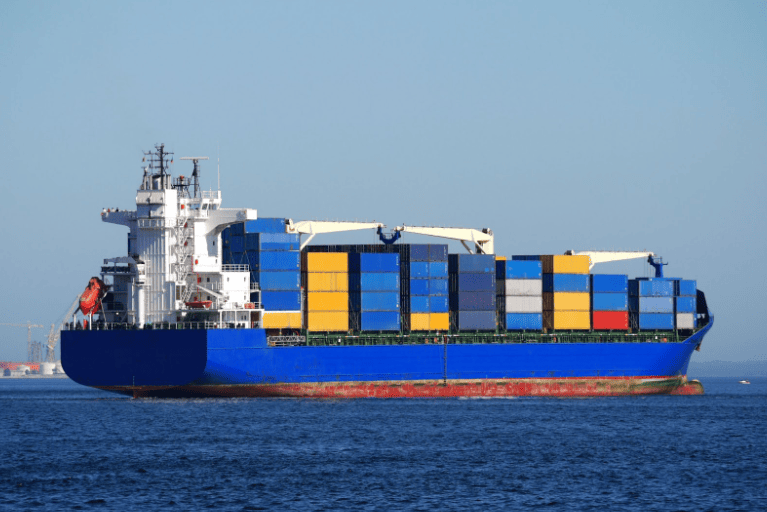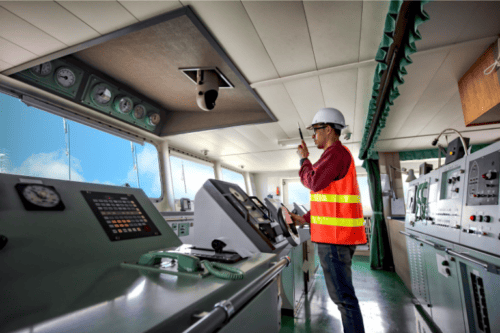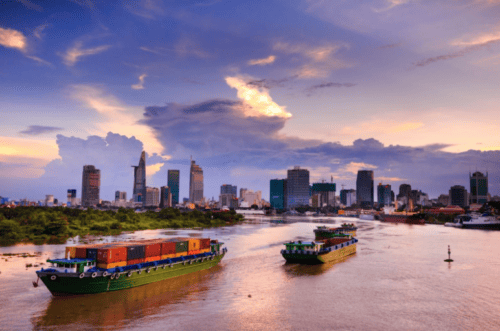Container Ship: Definition, Types, and Design

Container shipping allows even small manufacturers and business owners to take advantage of economies of scale and transport their products to consumers around the world.
Though many people have some understanding of what a container ship is and how they work, few understand the process on a detailed level, including operating costs, supply chain, port congestion, container shortage, fuel costs, and fuel consumption.
In this article, we will describe container ships in detail, including what they are and how they came to be. First, we’ll discuss their many designations and important features. Then we’ll zoom in on the type of shipping container they each carry. Finally, we give an overview of the shipping process from port to port.
What Is a Container Ship?
Container ships are large vessels that carry dry cargo in intermodal containers. Unlike general cargo ships, container ships use containers that are standardized in terms of size and container ship capacity.
Standard-size containers maximize cargo space, allowing each ship to carry a maximum amount of goods, ranging from fresh produce to lumber to automobiles.
Using a fixed route and schedule, these dedicated container ships can efficiently move cargo from one port to another, supporting global trade. Without container ships, our economy would not be what it is today. It would be too expensive to produce goods in foreign markets, limiting options to produce and market goods.
Development of the Container Ship
The container ship is largely responsible for our global trade economy, but it’s a relatively new invention. Before the turn of the 20th century, we placed barrels, sacks, and other non-standardized vessels on regular cargo ships.
Shipping this way was cost prohibitive for many, and only the biggest companies could take advantage of international trade.
All of that began to change in 1955 when an entrepreneur from North Carolina named Malcolm McLean realized reducing unnecessary cargo handling could lead to huge efficiency gains when shipping goods. So, he took an old World War II oil tanker, the SS Ideal X, and created the first container ship.
The first container vessels changed how we move cargo, but they were very small compared to the ones in use today. The SS Ideal X carried 800 twenty-foot equivalent units (TEU) at max capacity. The new container ships we rely on today easily transport 15,000 to 21,000 TEUs, and sometimes more.
Types of Container Ships
The evolution from 800 TEUs to 15,000 TEU capacities occurred over a variety of container ships and ultimately led to the creation of several container ship sizes and types.
Feeders
Feeders are small container vessels often found at small or inland ports. These new ships are usually approximately 492 feet in length and can carry up to 2,000 TEUs.
Their small ship size allows them to move through shallow waters that larger container ships can’t access. So, they “feed” the larger vessels.
Unlike larger container ships, feeder ships tend to have loading gear onboard. You may notice cargo cranes installed on their decks. That’s because the smaller ports they serve often do not have space for the larger lifting equipment necessary to move containers.
Feedermax
Feedermax ships function just like feeder ships, but as their name implies, they’re slightly larger. They have a 3,000 TEU capacity. You’ll see them in larger inland ports, like the Baltic Sea. You may also find them carrying specialty goods, including hazardous raw materials and oddly-sized cargo that can’t ship alongside other standard containers.
Panamax
The Panamax is 965 feet long with a 4,000 – 5,000 TEU capacity. It usually has a 106-foot beam and a 39.5-foot draft. These vessels were first built in the 1980s and designed to fit through the original Panama Canal.
Ships that could cut through the canal could significantly reduce international shipping time. However, the original Panama Canal was on the small side, which greatly limited the size of container ships until 2016.
Post-Panamax
Post- Panamax was the term the shipping industry gave ships that didn’t fit in the original Panama canal locks.
In the 1980s, when the Panamax came to be, many larger ships didn’t fit through the canal. Anything over 984 feet long couldn’t make it through the original channel. These ships earned the name Post-Panamax.
At the time, Post-Panamax ships were mainly vessels that could carry over 5,000 TEU. Today, only the largest ships are Post-Panamax ships, thanks to the Panama Canal expansion.
These ships have to traverse Cape Horn at the tip of South America and skip the canal altogether, greatly extending the time for products to ship. They are currently the largest container ships in use.
New Panamax
In 2016, the Panama Canal underwent an expansion. So, the New Panamax or Neopanamax designation came to be. This designation is for any ship that fits the width and depth of the new Panama Canal.
The new canal can accommodate ships over 1,300 feet long and 157 feet wide. These ships have up to a 12,500 TEU carrying capacity. Their increased capacity allows more goods to pass through the canal and avoid the long journey around Cape Horn.
Ultra Large Container Vessel
The largest container ships, the ultra-large container vessels, fall under the Ultra Large Container Vessel (ULCV) designation. These ultra-large container ships carry 14,000 TEUs or more and can be over 1312 feet long and up to 193.5 feet wide.
This size is too large for the Panama Canal, but the big ships can easily transit the larger Suez Canal. These larger ships run routes from the world’s busiest container port in Shanghai to ports in Northern Europe.
Container Ship Design

Container ship sizes vary, but they typically have the same essential features, including a bridge, cranes, cargo holds, and container security systems.
Bridge
The bridge is the commanding center of the container ship. It holds the navigational equipment and controls the ship’s engine. The bridge is where the captain and crew control the ship’s speed and direction. They also monitor the weather and sea conditions.
The bridge also serves as the location for internal and external communication. The captain can address their crew and other nearby ships through the communication equipment on the bridge.
Cranes
Though smaller ships like feeders may have cranes installed on their decks, most container ships rely on cargo cranes installed at the port. Each port crane has a cargo-carrying capacity that matches the size of the ships they serve, meaning there are Panamax cranes, Post-Panamax cranes, and so forth.
The largest cranes are impressive engineering feats. They stand as tall as Big Ben’s clock tower and can lift 100 tons. That’s equivalent to a small blue whale or the Space Shuttle Endeavor.
Cargo Holds
Cargo holds are enclosed spaces to carry containers beneath the ship’s deck. Each has a large carrying capacity, anywhere from 20 to 200,000 tons. And each one can meet specialized requirements. For example, a cargo hold meant to hold refrigerated containers will have plenty of access to power.
Cell guides within each cargo hold guide containers into place during the loading process. These metal guides help keep the containers stacked in perfect, organized rows.
On top of the holds are hatch covers. Hatch covers prevent elements, including water, from impacting the cargo. The covers also protect cargo, especially goods moving in open-top or flat rack containers.
Container Security
For container vessels to be useful, the containers must stay in place. Keeping towers of containers from toppling in varying sea and weather conditions isn’t easy, but it’s possible with the right container security.
Lashing systems are one form of container security. Lashing systems consist of wire ropes, rigid rods, chains, and tension devices to secure the containers to the ship. The addition of a twist-lock system attaches the container stacks, further securing the cargo.
On some of the largest container ships, a system of towers, or buttresses, sit at each end of every cargo hold. As deck workers load the ship, they add a removable stacking form to the towers, securing each container tier together for the ship owners.
Types of Containers

Container ships carry ISO containers, which are standardized in size and shape but can vary significantly by feature.
Dry Storage Container
Roughly 90% of ISO containers are 20 or 40-foot dry storage containers, used for shipping dry materials of all types. When you think of storage containers, you probably think of these.
Basic and made of steel, these containers are hermetically sealed but offer no temperature control or ventilation. Tie-down points along the bottom and top railings within the container allow shippers to secure all sorts of goods.
Flat Rack Container
Flat rack containers look like regular dry storage containers, but they don’t have sides, or sometimes they have sides that collapse. This allows them to accommodate larger or oddly shaped loads like cars or machinery.
In some cases, flat racks don’t have front, rear, or sidewalls. Instead, they just have the container’s corner posts. So, shipping companies can still stack them while accommodating atypical loads.
Open Top Container
Open-top containers are exactly what they sound like; they’re containers without a top. In some cases, the top exists but is a convertible. Just like the top of a convertible car, the roof can roll back when needed. This feature allows open-top containers to carry tall cargo, like logs or manufacturing equipment.
Refrigerated Container
Refrigerated containers or reefers offer temperature control, vital to certain bulk cargo types. As long as they are connected to a power source, these containers can maintain a temperature of -18 to 30 degrees Fahrenheit.
Perishable items like fruits and vegetables that cross the rough seas rely on shipping containers like these. Certain medications and pharmaceuticals also require refrigerated containers.
Side Open Container
Side-open containers have side doors that can shift so that the entire side of the container opens. Sort of like the curtains on a stage, workers can pull the side container’s sides back fully, allowing them to load the container with extra long or wide cargo.
Side open containers are also ideal when shipping cargo that requires ventilation. Certain produce and some plants do best in these containers.
Tank Containers
Tank containers hold steel tanks full of bulk liquid in a protective frame. The frame is an ISO standard size, so it can fit below or on top of other shipping containers.
The tank itself usually contains a non-corrosive protective barrier allowing the liquid inside to be either non-hazardous or hazardous. Besides liquid, these tanks can also carry chemicals, liquefied gasses, and certain food items.
Half-Height Containers
As their name suggests, half-height containers are half the height of normal containers. Just like dry storage containers, they are made of steel and are hermetically sealed. Inside, they may have multiple tie-down points, which help keep goods in place during transit.
Their smaller size makes them ideal for carrying heavy or dense items like stones, gravel, and coal. They also frequently carry pipes and tools.
How a Container Ship Transports Its Cargo
The process of shipping cargo via container ship begins with pre-departure paperwork and ends with unloading shipping containers at port facilities around the world.
Pre-Departure
Shipping goods on cargo ships begins when you place an order for goods from a manufacturer overseas. Usually, the manufacturer then works with a freight forwarding company to arrange transport of the goods from their factory to your business or home.
Freight forwarders are intermediary businesses that work with air, sea, rail, and truck companies to transport cargo from one location to another. They’re exceptionally helpful when you’re trying to move goods overseas because, more often than not, you’ll need to work with more than one shipping utility, and they help provide the necessary paperwork for each.
When shipping via shipping containers, you’ll need a bill of lading (BoL) and a freight bill. The BoL is essentially a shipping contract. It describes the cargo’s origin and destination. It also lists the goods’ quantity, description, and costs. Finally, the BoL documents the good’s title or ownership.
The freight bill is a shipping invoice. It lists the agreed-upon costs, including details about accessory charges. It also lists all services provided for shipping the cargo and their associated fees.
Loading
After the freight forwarding company arranges the route of travel and all parties have dealt with the necessary paperwork, the goods usually move by truck to the nearest port. The freight forwarding company will arrange for a truck to arrive at the manufacturer. Then, they will load an ISO container with the goods. After that, they’ll drive the container to the nearest port.
At the port, workers use cranes to load containers onto the ship. Each container has a specific bay, row position, and tier or level based on its specific needs. For example, a refrigerated container will be in a cargo hold with easy access to a power source.
At this point, the freight forwarder will provide the shipping company with all the necessary manifest data, like the contents of the container, who owns it, and its ultimate destination. The shipping company must forward this data to the origin and destination port’s government.
Journey
After the cargo ship is loaded, it’s ready to sail. With any luck, weather and sea conditions will allow the ship to reach its destination on time and without mishap. Ensuring the containers are properly lashed and secured before the ship leaves port helps ensure the shipment makes it to its final destination fully and without damage.
Before reaching the destination port, the ship’s captain or the shipping company’s global documentation center will ensure the destination port’s local authorities have all the information they need to allow the ship in, including information on the ship itself, the crew, and the cargo it carries.
Unloading
When the ship reaches its destination, local authorities will clear it to enter the port. There, it will dock next to the appropriate port cranes, which dock workers will use to unload the ship. There can be as many as 100 dock workers for each vessel during unloading. These workers may specialize in lashing systems, crane operations, or other cargo equipment operations.
Once the containers are off the ship, customs must analyze the ship’s documentation. Then, they may select a few containers for further inspection. Once they inspect the containers to ensure they match the ship’s documents, they’ll clear the shipment.
After the goods clear customs, the container usually ends up on another truck. The truck, known as a drayage truck, will take it to a distribution center. At the distribution center, workers open containers and divide the shipment packets within them. Then, they ensure each packet makes it to the right addressee, whether by truck, rail, air, or further sea travel.
Frequently Asked Questions
Below, we answer a few of the most common questions regarding container ships.
How are container ships scrapped?
When a container ship is no longer in use and ready for scrapping, the owner of the vessel will sell it to a breaker company. The breaker company breaks the ship down into usable bits of steel and other scrap metal then resell the pieces.
Which is the largest container ship operator?
The world’s largest container ship operator is the Mediterranean Shipping Company (MSC). They operate 730 vessels in total, 413 of which are container ships. Their fleet services 260 routes to 150 countries. Close behind MSC in terms of capacity are France’s CMA CGM and Denmark’s Maersk Line.
What is the average age of a container ship?
According to the shipping analytics firm Clarksons Research, a container ship’s average age is 14.1 years old. This is up from 11 years old five years ago.
Which country has the most container ships under its flag?
Panama has the most container ships under its flag. Though there is only one shipping company in Panama, many shipping companies sail under Panama’s flag because they offer an open ship registry, strategic location, favorable tax laws, and low wages.
What are shipping charter agreements?
A shipping charter agreement is an arrangement in which a shipowner hires out their vessel to carry cargo from one port to another. The shipowner retains control of the navigation and management of the vessel, but the charterer engages the ship’s carrying capacity.
Conclusion
Container shipping has revolutionized our global economy, allowing even the smallest of businesses to take advantage of consumer markets around the world. Before the emergence of the container ship, we relied on non-standard vessels to move goods.
Barrels, sacks, and crates worked, but they were far from an efficient use of space, and they made loading laborious.
Container ships rely on standard containers. This maximizes cargo space and makes loading and unloading far easier. Thanks to container vessels, we now have an efficient way to move goods around the world, allowing a global economy to flourish.
